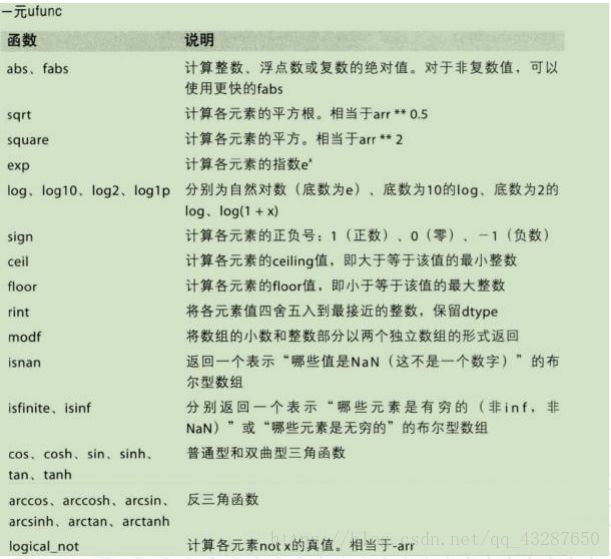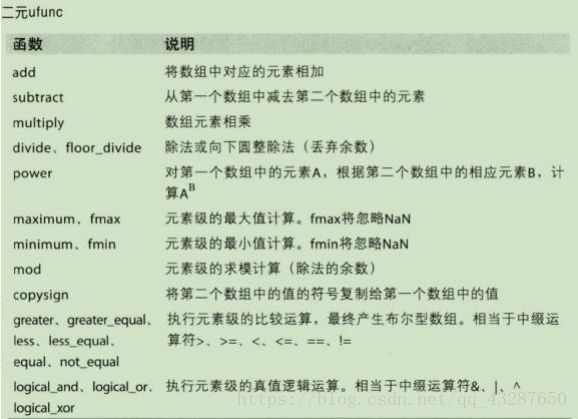python numpy--矩阵的通用函数
一、概念
通用函数(ufunc)是一种对ndarray中的数据执行元素级运算的函数。你可以将其看作简单函数(接受一个或多个标量值,并产生一个或多个标量值)的矢量化包装器通用函数的输入是一组标量,输出也是一组标量,它们通常可以对应于基本数学运算,如加、减、乘、除等。
二、分类
1.一元函数
它们接受一个数组。返回一个结果数组,当然也能返回两个数组(modf函数),但是这种的不是很常见;

(1)abs fabs
import numpy as np #导入模块
a = np.mat(np.arange(-4,3)) #创建一个矩阵
np.abs(a) # 对矩阵a取绝对值
np.fabs(a) # 对矩阵a取浮点类的绝对值
(2) sqrt () 平方根 square() 平方
b = np.mat(range(1,6)) #创建一个矩阵
np.sqrt(b) #b的平方根
np.square(b) #b的平方
(3)log log10 log2 log1p
c = np.mat([1,2,np.e,np.e+1,4,10,100]) #创建一个矩阵
np.log(c) #以e为底
np.log10(c)# log以10为底
np.log2(c)#log2以2为底
np.log1p(c) #在c的基础上每一个值加上一个1,再以e为底的对数 log1p(x)==log(1+x)
np.log1p(np.e-1)
(4)sign ceil floor rint
d = np.mat([
[2.3,4.6],
[1.2,1.8]
]) #创建一个矩阵
np.sign(d) #符号位 +1:正数 -1:负数 0:0
np.ceil(d) #向上取整 右
np.floor(d)#向下取整 左
np.rint(d) #四舍五入
e = np.mat([
[1,4,8],
[2,3,7]
])
# e*0.1 #快速变成浮点数
np.rint(e)#四舍五入的方法也可以
(5)modf 分别返回小数部分和整数部分
这就是输入一个数组,返回两个数组的函数
arr1,arr2=np.modf(d)
#arr1 返回的是小数部分,arr2返回的是整数部分
(6)isnan() 判断不是数字
nan: not a number
f=np.array([1,2,np.nan,np.nan,3]) #创建一个矩阵 不是数字的就转换为np.nan np.inf 是无穷大,是个数字类型
np.isnan(f)
(7)cos sin tan
g=np.mat([0,np.pi/4,np.pi/2,np.pi*3/4]) #创建一个矩阵,里面表示的是角度
g*2 #所有的角度都放大2倍
np.cos(g) # 求角度的cos值
np.set_printoptions(precision=3)#科学计数法设置显示3位小数,作为了解吧!
np.tan(g) #求角度的tan值
(8)logical_not
import numpy as np
a = np.mat(np.arange(-4,3))
print(a)
b = np.logical_not(a)
print(b)
2.二元函数
#准备三个矩阵
a = np.mat([1,2,3,4])
b = np.mat([5,6,7,8])
c = np.mat([9,10,11,12])
(1)power() 求幂
np.power(b,a) #矩阵本身是二维的,有人问为什么返回的结果是两个中括号
np.power(b,2)
(2)maximum、minimum 元素级运算
如果两个矩阵的元素不一样多的话则会报错
#准备两个矩阵
arr1 = np.mat([1,8,2,9])
arr2 = np.mat([6,3,5,4])
np.maximum(arr1,arr2)
matrix([[6, 8, 5, 9]])
返回的是两个数组中对应位大的数值。
np.minimum(arr1,arr2)
matrix([[1, 3, 2, 4]])
返回的是两个数组中对应位小的数值
(3)greater 大于 ,greater_equal 大于等于
得到的是布尔矩阵或则数组
np.greater(arr1,arr2)
matrix([[False, True, False, True]])
(4)逻辑"与":logical_and ,“或”:logical_or,“非”:logical_xor
在python中非0为真
#准备一个矩阵
d = np.mat('2 0;1 0')
e = np.mat('0 2;1 0')
#与
np.logical_and(d,e) #对应位都为真,结果为真,否则为假
matrix([[False, False],
[ True, False]])
#或
np.logical_or(d,e) #对应位其中一位为真则为真,都为假则为假
matrix([[ True, True],
[ True, False]])
#非
np.logical_xor(d,e) #相同为false ,不同是true
matrix([[ True, True],
[False, False]])
三、自定义通用函数
步骤:
step1:定义并设置函数内容
step2:使用np.frompyfunc(函数名,输入参数个数 Int ,输出值的个数 int)创建通用函数
1、自定义函数1,简单定义写个代码
# 写一个通用函数 返回与参数结构相同的zero矩阵
#step1:
def copyshape(a):
return np.zeros_like(a)
#step2:
ucopyshape = np.frompyfunc(copyshape,1,1)
#step3:使用函数
f = np.mat('1,2;3,4') #创建一个2*2的矩阵
ucopyshape(f) #返回的是与f矩阵相同结构2*2的值为0 的矩阵
matrix([[0, 0],
[0, 0]], dtype=object)
2、自定义函数2,返回所有元素的平方,传入一个参数,输出一个参数
# step1:
def square(a): # 定义函数名和参数
return a**2 # 返回参数的平方
#step2
usquare = np.frompyfunc(square,1,1) #使用该函数创建通用函数,传入一个参数,输出一个参数
#step3:使用这个通用函数
usquare(np.mat('1 3 5 7'))
matrix([[1, 9, 25, 49]], dtype=object)
3、自定义函数3,返回两个矩阵对应位的平方和,传入2个,输出1个
# step1
def square_add(a,b):
return a**2 + b**2
#step2
usquare_add = np.frompyfunc(square_add,2,1)
#step3:使用参数
g1 = np.mat('1 2 3 4')
g2 = np.mat('6 5 4 3')
usquare_add(g1,g2)
4、自定义函数4,返回一个矩阵的平方 第二个矩阵的立方 传入两个参数,输出2个参数
# step1
def square_cubic(a,b):
return a**2,b**3
#step2
usquare_cubic = np.frompyfunc(square_cubic,2,2)
#step3:使用函数
a,b = usquare_cubic(np.mat('1 2 3'),np.mat('4 5 6')) #因为输出的是2个,所以放2个变量来进行存储
四、numpy中已有的通用函数
1…add.accumulate()
递归作用于输入的数组,将运算的中间结果返回
axis决定方向
a = np.arange(9) #准备一个数组
np.add.accumulate(a)
array([ 0, 1, 3, 6, 10, 15, 21, 28, 36], dtype=int32)
以下加入axis:
axis=0表述列
axis=1表述行
a.reshape(3,3) #把数组a变成3*3的数组
array([[0, 1, 2],
[3, 4, 5],
[6, 7, 8]])
np.add.accumulate(a.reshape(3,3),axis=0) #竖着加
array([[ 0, 1, 2],
[ 3, 5, 7],
[ 9, 12, 15]], dtype=int32)
np.add.accumulate(a.reshape(3,3),axis=1) #横着加
array([[ 0, 1, 3],
[ 3, 7, 12],
[ 6, 13, 21]], dtype=int32)
2.add.reduce() 求和
axis决定方向
a数组是:
array([0, 1, 2, 3, 4, 5, 6, 7, 8])
np.add.reduce(a) #参数要是一个数组,矩阵就不适用了
36
以下加入axis:
b=np.arange(12).reshape(3,4) #准备一个3行4列的数组
array([[ 0, 1, 2, 3],
[ 4, 5, 6, 7],
[ 8, 9, 10, 11]])
np.add.reduce(b,axis=0) #竖着加
array([12, 15, 18, 21])
np.add.reduce(b,axis=1) #横着加
array([ 6, 22, 38])
3.add.reduceat()
需要输入数组以及索引值列表作为参数 按照区间计算方式进行求和
a数组是:
array([0, 1, 2, 3, 4, 5, 6, 7, 8])
#相当于sum(a[0:5]) sum(s[5]) sum(a[2:7]) sum(a[7:])
np.add.reduceat(a,[0,5,2,7])
array([10, 5, 20, 15], dtype=int32)
4.add.outer(a,b)
a的每一个值加上b的所有值,作用于第一个参数的元素以及第二个参数的整体
a数组是:
array([0, 1, 2, 3, 4, 5, 6, 7, 8])
c = np.array([1,3,5,7])
np.add.outer(c,a) # c的每一个值加上a的所有值
array([[ 1, 2, 3, 4, 5, 6, 7, 8, 9],
[ 3, 4, 5, 6, 7, 8, 9, 10, 11],
[ 5, 6, 7, 8, 9, 10, 11, 12, 13],
[ 7, 8, 9, 10, 11, 12, 13, 14, 15]])
np.add.outer(a,c) #a的每一个值加上c的所有值
array([[ 1, 3, 5, 7],
[ 2, 4, 6, 8],
[ 3, 5, 7, 9],
[ 4, 6, 8, 10],
[ 5, 7, 9, 11],
[ 6, 8, 10, 12],
[ 7, 9, 11, 13],
[ 8, 10, 12, 14],
[ 9, 11, 13, 15]])
np.add.outer(np.mat('1,2;3,4'),np.mat('4 5;6 7')) #返回的是一个数组
array([[[[ 5, 6],
[ 7, 8]],
[[ 6, 7],
[ 8, 9]]],
[[[ 7, 8],
[ 9, 10]],
[[ 8, 9],
[10, 11]]]])


